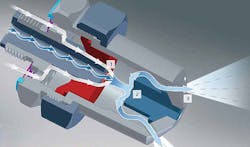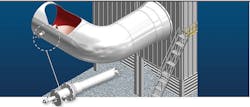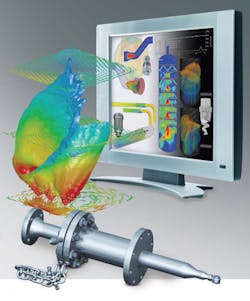Details Matter: How to Properly Position Spraying Equipment
Spraying should be a simple procedure. Just install a good nozzle, aim it at your target, and fire away, right?
Wrong.
As simple as it may seem from outside the industry, spraying applications involve extremely complex, precision equipment that is every bit as critical to quality manufacturing as any other piece of equipment on the floor.
As we have seen this last year from Spraying Systems Co.'s ongoing series on the subject, choosing the correct spraying equipment can mean millions of dollars in savings; it can mean better products and fewer rejects; at some level, it can even mean helping to create a better world.
This month, we're taking a deeper look into the complexities of spraying equipment, making the jump from nozzle selection to the process required to ensure that the equipment is installed accurately and appropriately to meet the needs of your application.
To do this, we met up with Bob Adams, Director of Engineering at Spraying Systems Co.
NED: Let's talk about nozzle positioning. Why is this so important when designing a system?
ADAMS: Every spray application is going to have some critical aspect of positioning—even applications as simple as pre-coating a sheet of steel before it enters a press.
Regardless of the application, the nozzles used or the spraying systems installed, the spray pattern needs to be correct. The flow certainly needs to be correct, and so do simple elements like height above the sheet and the angle of the tip in orientation to the sheet and to the other nozzles. This prevents overspray or interference between sprays.
"An improper nozzle setup can cause more problems than no spray at all."
These are very simple issues, but they have the potential to cause a lot of problems, especially for customers that cannot deal with overspray or misting.
Another important factor is the spray header itself and the sizing of the header based on the flow. That is something that is usually overlooked by customers because they think it's not an issue.
We'll go in and find that their fluid velocities through that pipe are extremely high and consequently are creating a lot of turbulence. Usually, they have no idea this is happening but it can cause problems with spray coverage.
So we find that even the simplest of applications aren't that simple unless you really know what you’re doing.
NED: What are the consequences of an improper spray header setup?
ADAMS: What you'll see is incomplete spray angles; you'll see streakiness in the spray and unbalanced coverage; you'll see that distribution isn't good. If the velocity is too high, you could be starving the nozzles, meaning you don't have enough flow to fill and give the nozzles the capacity that they need.
If you introduce turbulence, and if you don't take that into consideration, you will get streaky sprays and incomplete spray.
An improper nozzle setup can cause more problems than no spray at all.
When we design a spray header system for a customer or help them with nozzle installation, those are the things that we're looking for because our solution must provide complete spray coverage.
For us, everything starts with that nozzle and how we can provide uniform coverage, then we work backward from there.
NED: What are the biggest mistakes you see with this in the market?
ADAMS: One of the biggest mistakes we've seen is people put the nozzles either too close together so the sprays interfere or they use the wrong type of nozzle and they get a very heavy streak, or striping and therefore a very heavy amount of fluid in certain areas.
This may lead to hot spots and cold spots in steel sheet, for example. That's very, very critical.
In that market, you cannot have overlapping sprays because it will create heavy edges. That will cause striping, and more cooling in that area, which is detrimental to the end product.
NED: Okay, so what do manufacturers have to do to guarantee proper spray?
ADAMS: Once you’ve chosen the best nozzle for the application, you have to do your geometry. You have to get your flows correct and your spray header correct. You have to take into account the height above the conveyor that you are spraying on, and you have to find the right spray angle to give you the effective coverage you need.
Once you do that, then you have to be sure that your nozzles do not interfere with one another.
In other words, if you look down at the sheet through the top of the header pipe, the nozzles should be offset so the patterns won’t interfere with each other but will still provide uniform coverage.
For a header design, you want to use a tapered edge so if you looked at one nozzle spraying, you have a higher concentration in the center and it tapers off towards the edges.
That provides the ability to put two nozzles closer together you, spaced in such a way that you get maybe 10 to 30% overlap, depending on the nozzle of course.
With that overlap, the sprays won’t interfere with each other.
And when you look at the distribution of an entire header you, will now get an even distribution of fluid.
NED: This makes sense for simpler applications where you can actually see the spraying system work, but what do you do for more complex jobs in closed environments?
ADAMS: For complex installations such as positioning a nozzle lance in a cooling tower or ductwork in the process industry, we use CFD [Computational Fluid Dynamics] analysis. This allows us to model the customer’s ductwork, their systems, and their towers to get a precise representation of what is happening based on their conditions.
We can model that to let us see all of the temperatures and the velocities of the gases in there. Then we can help them position the nozzle lances in that tower in such a way that we can achieve the desired cooling and virtually eliminate any issues with improper evaporation of the droplets.
NED: So there really is nothing simple about this. How do manufacturers without a dedicated engineering team tackle a project like this?
ADAMS: They don't have to. This isn't really their business; it's our business. That's why we have full-service sales engineering offices. We’re able to come in and help any customer regardless of the application.
Our sales engineers are trained to look at exactly what parameters you have and help design what needs to be done.
We can help customers with standard products or with custom designs. They may have a system in place, but they want to tweak the performance, and they don't want to replace all their headers or their pumping systems or whatever.
We can certainly come in and help them optimize an existing system. Or, if the case requires, we can develop a brand new nozzle and spray header for them that may have a specific angle or specific flow rate for them. No matter what’s required, we can provide the technical assistance that’s needed.
Find out more at Spraying Systems Co.



